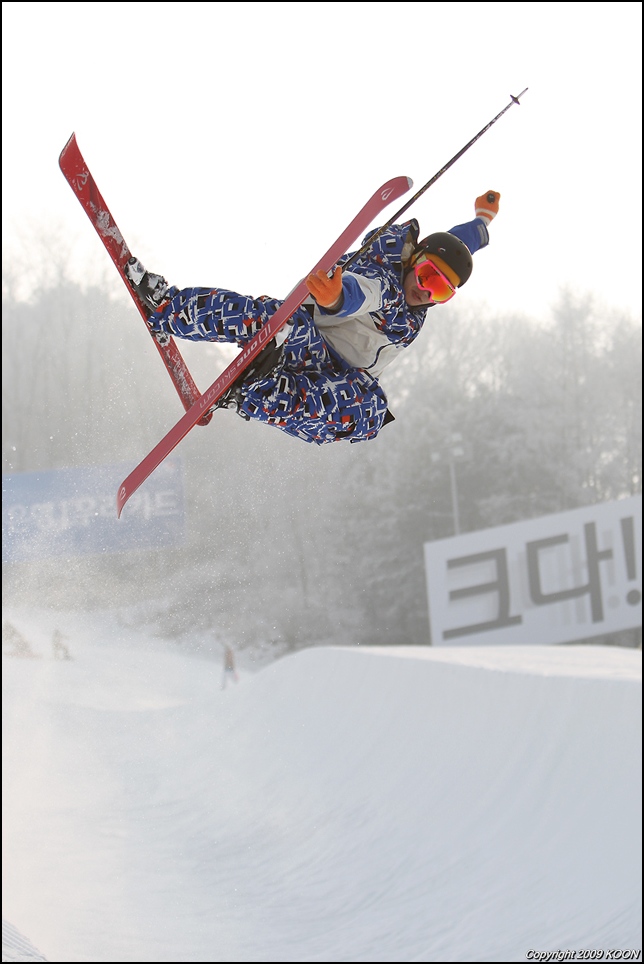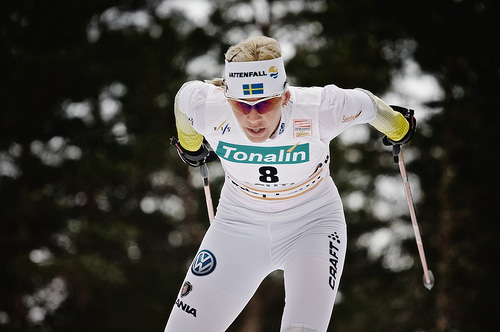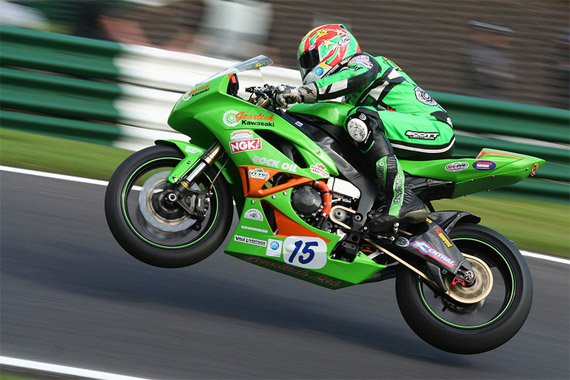1. 카메라
스포츠 촬영용 카메라라는 SLR(DSLR) 카메라가 가장 적합하다.
그 이유는 셔터랙이 적기 때문이다.
똑딱이는 셔터랙이 길다. (예, Nikon Coolpix L3는 1.8초)
RF카메라는 셔터랙이 짧다. (예, Leica M9 은 0,08초)
(토달기)
제가 스포츠 사진을 찍으려 DSLR 카메라에 입문한 첫번째 이유도 바로 이 셔터랙 때문입니다.
초점이 맞건 안맞건.. 우선 원하는 순간을 포착하기 위해서 가장 중요한 요소가 아닐까 싶습니다.
또한 SLR이 좋은 이유는 파인더로 보는 것과 찍는 것이 (거의) 일치 한다는 것입니다.
물론, 똑딱이도 그렇지만, 이전에 RF 카메라들을 쓸 때에는 일치하기가 쉽지 않았지요.
그러나, 자신이 표현하고 싶은 바에 따라서는 꼭 SLR카메라를 쓰지 않아도 됩니다.
스포츠 다큐멘터리 같은 사진이나, 인물 촬영 혹은 연출 촬영을 할 경우에는
용도에 맞는 적절한 카메라를 쓸 수 있습니다.
파크에서 조명 + 핫셀브러드를 쓰기도 합니다.
2. 지저분한 배경 정리하기
배경에 관중이나 광고판등이 나오지 않게 배경을 정리하는 것이 중요합니다.
그러기 힘들다면 가능하면 배경에서 피사체를 분리시켜서 촬영하세요.
(토달기)
배경을 정리하는 방법 중에 하나가 아웃 포커싱입니다. 가능한 망원을 쓰고, 같은 초점거리라도
심도를 낮게 하면 배경이 더욱 깨끗하게 정리가 됩니다.
광고판의 글씨가 사진에 들어가게 되면 사람들은 광고글을 읽으려 시선을 빼앗기게 됩니다.
피사체(선수)에 집중이 될 수 있는 배경이 되도록 원하는 앵글을 잘 찾아야 합니다.
단, 스폰서를 알리기 위해서 광고판을 삽입해야 하거나, 광고 문구와 피사체가 적절히 조화되어서
의미있는(멋있는) 사진이 된다면 포함해도 괜찮습니다.
 EXIF Viewer제조사Canon모델명Canon EOS-1D Mark III소프트웨어PhotoScape촬영일자2009:01:17 13:54:14노출시간 0.001 s (1/2000) (1/2000)초감도(ISO)100조리개 값F/f/3.5조리개 최대개방F/3.5125043207466노출보정0.33 (1/3) EV촬영모드aperture priority (semi-auto)측광모드matrix촛점거리70.00 (70/1)mm사진 크기644x964
EXIF Viewer제조사Canon모델명Canon EOS-1D Mark III소프트웨어PhotoScape촬영일자2009:01:17 13:54:14노출시간 0.001 s (1/2000) (1/2000)초감도(ISO)100조리개 값F/f/3.5조리개 최대개방F/3.5125043207466노출보정0.33 (1/3) EV촬영모드aperture priority (semi-auto)측광모드matrix촛점거리70.00 (70/1)mm사진 크기644x964  EXIF Viewer제조사Canon모델명Canon EOS 20D소프트웨어PhotoScape촬영일자2008:02:24 15:36:25노출시간 0.001 s (1/1000) (1/1000)초감도(ISO)100조리개 값F/f/4.0조리개 최대개방F/4노출보정1431655765.00 (4294967295/3) EV촬영모드aperture priority (semi-auto)측광모드matrix촛점거리105.00 (105/1)mm사진 크기904x604
EXIF Viewer제조사Canon모델명Canon EOS 20D소프트웨어PhotoScape촬영일자2008:02:24 15:36:25노출시간 0.001 s (1/1000) (1/1000)초감도(ISO)100조리개 값F/f/4.0조리개 최대개방F/4노출보정1431655765.00 (4294967295/3) EV촬영모드aperture priority (semi-auto)측광모드matrix촛점거리105.00 (105/1)mm사진 크기904x6043. 기본 철칙을 잊지 말자!
The rule of faces
선수의 살아있는 표정이 드러난 얼굴이 포함된 사진이 좋다.
정안되면 뒤통수라도 찍어라.
(토달기)
선수(모델)와 눈이 마주치는 사진이 더욱 집중력을 갖고 있습니다.
그래서, 가능하면 선수와 눈이 마주치는 사진을 찍도록 노력합니다.
그래서, 고개 빳빳이 들고 있는 선수들이 셔터가 더 가게 되어 있습니다.
가끔 모르는 사람들을 찍느라 주저하는 경우도 있는데, 초상권은 찍고 난
이후에 해결해도 가능합니다. 그 멋진 순간은 두번다시 오지 않습니다.
The rule of thirds (황금분할 법칙)
피사체를 가운데 두는 것도 멋지지만. 3분할 법칙에 맞춰서 구도를 잡는게
좋습니다.
(토달기)
중저가 카메라들은 AI-Servo(C모드) 초점을 중앙 포인트만 잡을 수 있는 경우가
있습니다. 그럴 경우에는 주변을 조금 여유있게 촬영을 하여 3분할 법칙에 맞게
크롭을 하는 것도 좋은 방법 입니다.
(상급 기종으로 오니 AF 포인트를 맘대로 조절할 수 있어서 좋더군요)
4. 블러도 좋다. (패닝)
스포츠 사진에서는 블러가 움직임을 표현하기에 잘 이용할 수 있다.
(토달기)
아울러, 패닝은 앞서 이야기 한 것중에 배경과 피사체를 분리시킬 수 있는
방법 중에 하나 입니다. 평상시에 틈틈이 연습하고, 언제 패닝을 써야 할 지
잘 판단해서 쓰는게 좋을 것 같습니다.
------------------------
* 원본링크
http://www.picturecorrect.com/tips/tips-for-great-sports-photography/
Sports photography is a large topic, and would require extensive review to truly do it justice here. However, a brief overview of how to get the best sports shots can be found in these four handy tips. Grab your camera and get ready for some sport, as I’m going to show you how to get those shots that the newspapers love!
1. Don’t forget that camera!
I often find that SLR (single-lens reflex) cameras are best for sports photography. Obviously, sports photographs are action shots, meaning that you’ll need to have good reflexes to snap that once-in-a-lifetime shot. I recommend SLR or DSLR cameras because point-and-shoot cameras often experience what is called shutter lag, or the time between you pressing the button and your camera taking the image. For ‘happy snaps’ (vacation shots, etc.), this does not matter, as your subject will usually stand stationary for longer than the period of shutter lag. However, in sports photography, quick timing is everything. Compact point-and-shoot cameras usually have the longest shutter lag (the Nikon Coolpix L3 with 1.8s) and rangefinder cameras have the least shutter lag out of digital cameras (the Leica M9 takes 0.08s to take an image). However, the shutter lag for SLR cameras is insignificant.
Generally, the greater the lens focal length, the wider your shot will be. This is a consideration in sports photography, as soccer and football pitches can often require great lens focal length.
2. Avoid background noise
Take a look at any good sports photograph, and you will notice that the background noise has been reduced. A shot on the far side of a field will often feature spectators, advertisements and other distractions which can wreck your brilliant shot. If it is not possible to distinguish the subject of your shot from the background, the shot might not be worth using. Remember though, if you have no other option, this may be your only choice.

"World Cup Womens Lahti, Finland" captured by Kirby Wilson (Click Image to See More From Kirby Wilson)
3. Placing your shot – rules to keep in mind
The rule of faces: A subject’s facial expression can make or break a shot. If you plan on selling your sports photographs, keep in mind that many editors want to be able to see the emotion on the sportsperson’s face – that is, a photo covering a play from behind may be passed up in favor of one covering the same play from in front, showing the player’s face. If it’s not possible to get a shot of a player’s face, a ‘back of head’ shot may be your only option, but be prepared for rejection by some leading photo editors.
The rule of thirds: Centering the subject of a photo can often be useful, but many photographers live by the ‘rule of thirds’, which dictates that important compositional elements of a photograph should be placed on one of the intersections between imaginary vertical and horizontal lines dividing the photograph into thirds. Advocates of the rule of thirds argue that this technique creates more energy in the photo than a centered shot.
4. Blurring is good
Budding photographers are nearly always instructed to minimize the blur in their photographs. In non-action photography, blur can be a bad thing. There’s nothing worse than getting your photographs back from developing, only to find that the subject of the photograph is indistinguishable from the background due to blur. However, in action photography, blur can be good, as it implies movement. When you see a soccer ball sliding through the air, your eye does not capture the image as still, so nor should your photographs. Do some practice using varying shutter speeds to get that optimal blur. It could make or break your shot.
There you have it. Four handy hints to getting the best sports photograph possible. If it’s not possible to get into the action, why not capture it with a photograph?
About the Author
Julie Spaulding is the owner-operator of How to Develop Film, the web’s premier source on film developing, and the author of The Photography Cash Cow: 5 Secrets to Monetizing Your Photos, due for release in late June 2010.

 [Tip] Premiere cs5 CUDA 활성화 방법
[Tip] Premiere cs5 CUDA 활성화 방법







